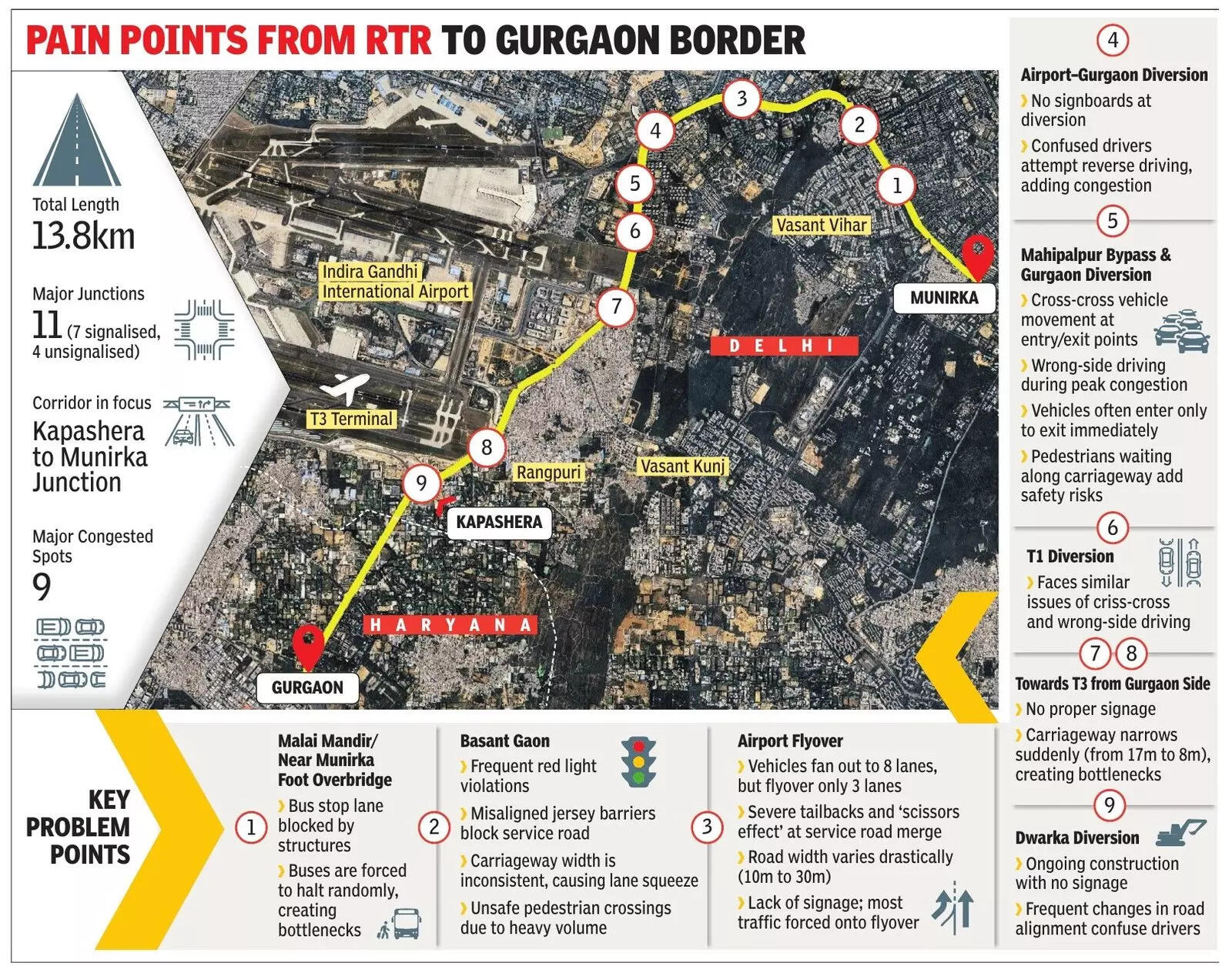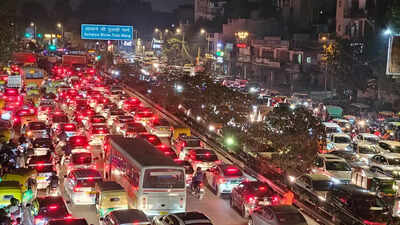NEW DELHI: Between Rao Tula Ram Marg and the Delhi–Gurgaon border on National Highway 48, there are several stretches that have flawed road geometry, missing signage and heavy vehicular movement. Poor driving discipline combines with these to make this one of the city’s most frustrating drives, according to the Institute of Road Traffic Education (IRTE).TOI had reported that Delhi Traffic Police, in association with experts, had launched a traffic engineering study of two key south Delhi corridors — RTR Marg and Chirag Dilli — to identify congestion triggers and suggest long-term fixes. The findings on RTR are now in, while sources said Chirag Dilli had also been reviewed earlier.The 13.8km RTR stretch is Delhi’s gateway to Gurgaon and Indira Gandhi International Airport and links Dhaula Kuan, Munirka and Vasant Kunj with the business hub of Cyber City. It also joins the highway to Jaipur. Between Kapashera and Munirka, there are 11 major intersections — seven of them signalised.A traffic officer said, “On a stretch as critical and as long as this, it’s important to first understand the exact problems before framing solutions. Mapping these points can give us a clear direction to work on both immediate measures and long-term fixes. Now we can ask what the solutions for congestion can be and move forward in that direction.”

Rohit Baluja, director, IRTE, said, “This corridor is not just a city road but a major arterial link connecting south Delhi with NH48, the airport and several defence institutions. Regular jams during peak hours cost millions of man-hours, cause fuel wastage and add to pollution. The single biggest gap is the haphazard traffic engineering — lanes that contract and expand abruptly, buses parked along the route, the Sunday bazaar near Malai Mandir, signals not aligned to codes, and, importantly, missing information signboards.“IRTE, he said, had identified at least nine critical problem spots. “Unless lane uniformity, proper signage and stricter enforcement are ensured, piecemeal solutions will keep failing. The issues have been mapped and presented to Delhi Traffic Police, who having to bear the brunt of traffic management, often resort to ad hoc remedial measures. It is the obligation of the road maintenance and operating authorities to ensure traffic moves efficiently,” he said.Among the nine areas flagged by IRTE, is the Malai Mandir spot close to the Munirka pedestrian overbridge, where the designated bus lane is blocked by structures. With no halting area, buses stop randomly on the road. Each unscheduled halt sends brake lights flashing down the line and a jam builds up quickly.The chaos grows at Basant Gaon, barely a kilometre away. Frequent red-light violations and misaligned jersey barriers meant to manage the service road actually choke the carriageway. The geometry forces vehicles to jostle for space, while pedestrians are left to dart across dangerously through gaps in heavy traffic.The most dramatic mismatch between design and demand is on the airport flyover close to NH48. Vehicles fan out into as many as eight lanes before being squeezed onto a three-lane flyover. The compression sets off massive tailbacks, worsened by the ‘scissors effect’ of cars weaving in and out to access service roads. Road width also fluctuates wildly between 10m and 30m. And the absence of clear signboards means many drivers find themselves on the flyover whether they want to or not.If the flyover is a squeeze, the diversions around it are even more dangerous. At the airport–Gurgaon diversion, drivers play a guessing game because of the absence of signage. They often overshoot the turns and attempt to reverse in the fast-moving lanes. Just ahead, the Mahipalpur Bypass and Gurgaon diversion descend into mayhem, with vehicles clashing at entry and exit points, pedestrians stranded on the edge of the carriageway and people routinely driving on the wrong side. With no designated bus stands, buses also stop in the middle. The nearby IGI Terminal 1 diversion faces similar cross-cross movements and wrong-side driving.Further ahead, the under-construction Dwarka diversion is marked by barricades, dust and ever-changing alignments with no signage, causing much confusion. Even going to T3 has its hurdles. At two points, the carriageway suddenly shrinks from 17m to just 8m with no warning.Problems don’t let up at some junctions. At the Munirka junction, the traffic lights beneath the flyover often malfunction, resulting in traffic moving in all directions. Moti Bagh junction sees similar problems.Amid all these, the absence of unambiguous signage is a recurring theme. From flyover approaches to diversions, the missing signboards force drivers to rely on guesswork, multiplying risks and creating jams.











